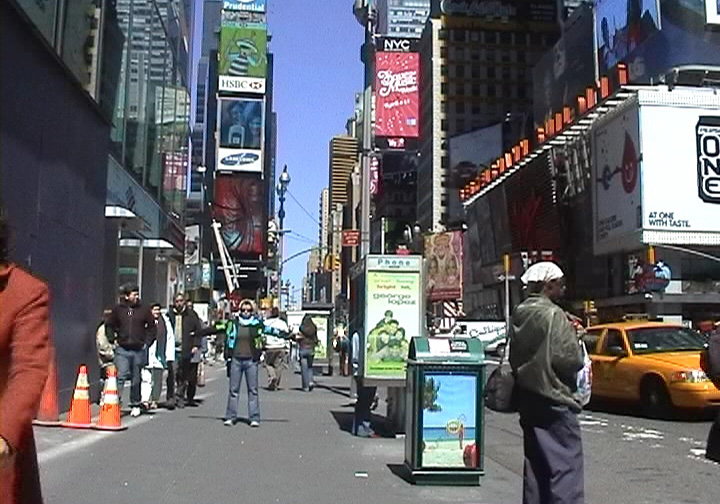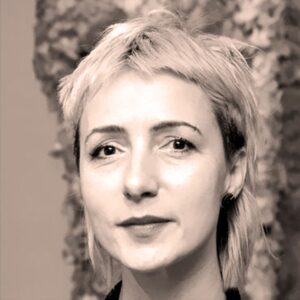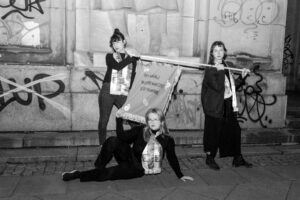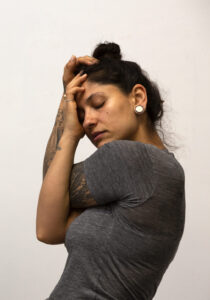Daniela Baráčková
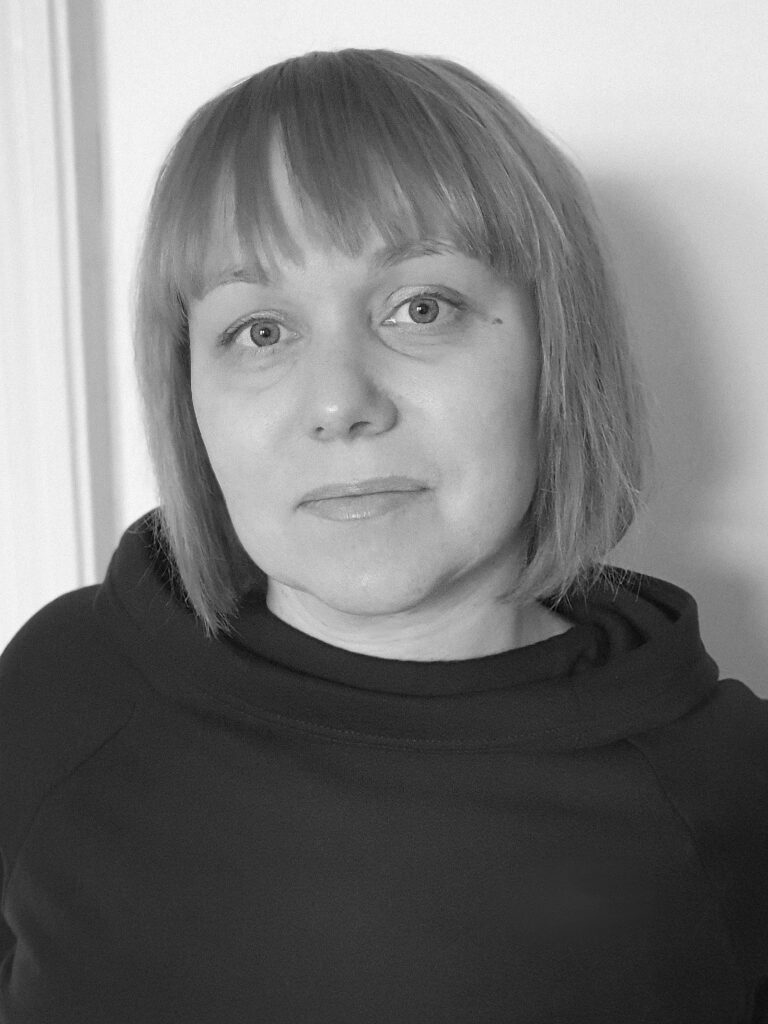
– born 1981 – graduated from Masaryk University’s Faculty of Education in Brno and the Academy of Arts, Architecture and Design in Prague (UMPRUM). Since 2015, she has run the architectural studio No Architects, which she established with her husband Jakub Filip Novák. In her art, she works primarily with short video performances, in which she uses significant points and grand gestures to express herself on personal and community social themes.
(Don’t) Overwhelm the World with Me
My studies at UMPRUM with Jiří David and Milan Salák were crucial for me. That’s when I decided to do art professionally. The support and encouragement from my professors meant a lot to me personally as well. It was only later, from a distance, that I began to look at the studio critically. I realized that it was built mainly on male concepts of success: to be the best, to excel over others … only later was I able to free myself from this way of thinking.
Just after my first child was born, I began to think about feminism from a different perspective. Until then, I had lived quite a social and bohemian life: I spent most of my time at UMPRUM or in a nearby bar, where we mainly talked about art. However, in my last year, I got pregnant at the same time my father suffered a stroke, became paralyzed, and acquired global aphasia. It was a difficult period. All at once, many things were changing. I had a very difficult pregnancy; I couldn’t do anything, not even art. My father was dying in my arms … Suddenly I saw things differently, as if I were making my way from the outside in. I read a lot, engaging with these topics on a theoretical level. I was trying to comprehend what I was going through. I grew up in the countryside, where some women still think that their job is to cook well for men (We Cook For Men, 2011)1. Feminist texts helped me take a closer look at gender stereotypes. This was very insightful for me.
The video Pičus is related to my “feminist coming out” (Pičus, 2014).2 In 2014, I showed it at Gallery 207 and organized an accompanying discussion on feminism. I think that I was one of the first to open up the theme on a personal level, particularly in connection with the management of the studios at UMPRUM. At that time, I still felt my opinions were quite unusual among artists’ circles, but since my studies, the discourse has shifted significantly (that is, in a very short time). Even in the context of my own history, then, I have a positive view on the future of feminism. The issue of gender is increasingly thematized in artistic environments and we are more often confronted with it than in architecture, for example.
My husband Jakub and I have run a studio for the last five years, and I am primarily dedicated to designing architecture, which is enjoyable and fulfilling. Unlike making art, it is more of a service, and also more systematic – the chaos of working in a gallery sometimes exhausted me. Architecture is now my trade, I only have perhaps two exhibitions per year now. For this reason, I revel more in my time with myself and in my art, and I also maintain a certain distance from the artistic community and even from my own work. I think about how much making art is about ourselves, and I wonder, why should I overwhelm the world with me? My work reflects a lot about my personal life, which I try to capture in a broader, generally more understandable context. I devote myself to my lived experience, so I cannot know what I will process five years from now. My topics are relationships, communication, situations, politics, and a certain sense of commitment, but perhaps now I could work with topics such as a middle age crisis, or the hardships of old age, reflecting my recent experience with my parents.
In my past videos, I primarily worked with myself and my environment. The intention was to capture my life as authentically as possible (e.g. Situation, 2009)3. Country man is probably my most known work (Country man, 2006)4, but it’s so old that I don’t quite identify with it anymore. I feel like a different Daniela made it. When I was on maternity leave, physical limitations in space was a big theme for me, among others. I became aware of the limits of the city and public space, which mothers traverse less often – your living space becomes narrower. Suddenly, when you want to move freely and have social contacts as you did before, you see all the barriers standing in your way. This experience inspired a video about housing estates (Tower Blocks, 2011)5. The stereotypes around women-perfectionists was also a theme in several of my 2018 videos (That’s Perfect, Wall, Blankets, 2018)678. My most recent works feel a bit different from the previous ones. They are less specifically about me9.
I love heritage museums, although I know that they represent a romantic and idealized view of the past. The video Skanzen (Skanzen, 2013)10 was part of the project Death, Czech Smallness and Contemporary Museums. The exhibition was created for the Jindřich Chalupecký Award. It dealt with the topics of history and national identity11. I was impressed by the exposition of the Libeskind Jewish Museum in Berlin, which showed how it is possible to present public history in a friendly and contextual way. My father also died around that time. In this way, the themes of death and historical interpretation were connected, which I dealt with through the history of my own family. When one works on oneself, one is critical of the environment in which one has lived and grown up, and one also realizes a certain limitation – smallness. The exhibition was a mishmash of these impulses; maybe there were too many of them, yet for me this series is still very telling.
When someone sees one of my videos and laughs, I feel like they understand it. Humor is an important part of a lot of my work. It gives the work an overview or a superstructure, then it does not seem so activist in nature. Politics clearly played a role, for example, in the Times Square video. (Times Square, 2006)12 When I was shooting remake of Jiří Kovanda’s performance, I didn’t know that he himself had perceived it apolitically. I learned that from him later. He considered his act more personal, while I intended my remake as a political gesture … The idea that politics is everything and all art is political is rhetorical. Yet I have always lived politics and activism. They are an essential part of me and therefore one aspect of my work.
Written in cooperation with Kristýna Péčová (2020).
1Image:Daniela Baráčková, Vaříme pro muže [We cook for men], 2011, performance. Courtesy of the artist.2Image: Daniela Baráčková, Pičus, 2014, video. Courtesy of the artist.
3Image: Daniela Baráčková, Situace [Situation], 2009, video. Courtesy of the artist.
4Image: Daniela Baráčková, Country man, 2006, video. Courtesy of the artist.
5Image: Daniela Baráčková, Výškové budovy [Tower Blocks], 2011, video. Courtesy of the artist.
6Image: Daniela Baráčková, That’s perfect, Zeď, Deky [That’s Perfect, Wall, Blankets], 2018, video. Courtesy of the artist.
7Image: Daniela Baráčková, That’s perfect, Zeď, Deky [That’s Perfect, Wall, Blankets], 2018, video. Courtesy of the artist.
8Image: Daniela Baráčková, That’s perfect, Zeď, Deky [That’s Perfect, Wall, Blankets], 2018, video. Courtesy of the artist.
9See: http://futuraprague.com/futura/event/452--daniela-barackova-tereza-severova-jen-dalsi-misto.
10Image: Daniela Baráčková, Skanzen [Open Air Museum], 2013, video. Courtesy of the artist.
11See: https://www.sjch.cz/daniela-barackova/.
12Image: Daniela Baráčková, Times Square, 2006, video. Courtesy of the artist.
– narozena 1981 – vystudovala Pedagogickou fakultu Masarykovy univerzity v Brně a Vysokou školu uměleckoprůmyslovou v Praze (UMPRUM). Od roku 2015 vede také architektonické studio No Architects, které založila se svým manželem Jakubem Filipem Novákem. Ve své umělecké praxi se nejčastěji věnuje krátkým video-performance, v nichž se skrze nápadnou pointu či lapidární gesto vyjadřuje k osobním i obecným celospolečenským tématům.
(Ne)zahlcovat svět sama sebou
Studium v ateliéru Jiřího Davida a Milana Saláka na UMPRUM pro mě bylo zásadní. Tehdy jsem se rozhodla, že budu umění dělat profesionálně. Podpora a povzbuzení od autorit pro mne i lidsky hodně znamenaly. Až s odstupem jsem na ateliér začala nahlížet také kriticky. Uvědomila jsem si, že byl postaven převážně na mužském způsobu úspěchu: být nejlepší, vynikat nad ostatní… Od tohoto pohledu jsem se osvobodila až později.
Teprve potom, co se mi narodilo první dítě, jsem o feminismu začala přemýšlet z jiné perspektivy. Do té doby jsem žila dost sociální a bohémský život: většinu času jsem trávila na UMPRUM nebo někde poblíž v baru, kde jsme řešili hlavně umění. Poslední rok školy jsem ale otěhotněla a ve stejný měsíc dostal můj otec mrtvici, ochrnul a trpěl globální afázií. Bylo to náročné období. Mnohé se naráz změnilo. Měla jsem velmi těžké těhotenství, nemohla jsem dělat nic, ani umění, otec mi umíral v náručí… Najednou jsem viděla věci jinak, jako bych se zvenčí dostala dovnitř do sebe. Hodně jsem četla a otevírala si tato témata z teoretické roviny, snažila jsem se porozumět tomu, čím procházím. Vyrostla jsem na venkově, kde si některé ženy dodnes myslí, že jejich úkolem je muži dobře navařit. (Vaříme pro muže, 2011)1 Texty o feminismu mi pomohly genderové stereotypy ostřeji nahlédnout. Bylo to pro mě prozření.
Video Pičus souvisí s mým „feministickým coming outem“ (Pičus, 2014)2. Vystavila jsem ho v roce 2014 v galerii 207 a uspořádala jsem k tomu diskuzi o feminismu. Myslím, že byla jedna z prvních, která toto téma otevírala v osobní rovině, i v souvislosti s vedením ateliérů na UMPRUM. Tehdy jsem si ještě v okruhu umělkyň připadala s takovým názorem celkem ojediněle, ale od mých studií (tedy za velice krátkou dobu) se diskurz výrazně posunul. I v kontextu vlastní historie proto vidím budoucnost feminismu pozitivně. Otázka genderu se v uměleckém prostředí tematizuje a jsme s ní všichni častěji konfrontováni – více než například v architektuře.
Posledních pět let mám s manželem Jakubem studio a věnuji se primárně navrhování architektury, které mě baví a uspokojuje. Na rozdíl od umění je spíše službou a je také systematičtější – chaos galerijního provozu mě občas vyčerpával. Architektura je moje živnost, výstavy mám teď třeba jen dvě ročně. Díky tomu si umění a čas sama se sebou více užívám a získávám také určitý odstup od umělecké komunity i své vlastní tvorby. Přemýšlím o tom, nakolik je umění o nás samotných, a uvažovala jsem, proč zahlcovat svět sama sebou. Moje tvorba totiž hodně odráží můj osobní život, který se snažím zachytit v širších, obecněji známých souvislostech. Věnuji se tomu, co bytostně prožívám, proto ani nyní nevím, co budu zpracovávat za pět let. Mými tématy jsou vztahy, komunikace, situace, politika i určitá angažovanost, ale teď to navíc může být krize středního věku, nebo útrapy stáří skrze aktuální žitou zkušenost s rodiči.
Dříve jsem ve svých videích používala hlavně sebe a své okolí. Záměrem bylo co nejautentičtější zobrazení (např. Situace, 2009)3. Mým nejznámějším dílem je asi Country man (Country man, 2006)4. Je ale tak staré, že už se s ním úplně neidentifikuji. Mám pocit, že to byla jiná Daniela. V souvislosti s mateřskou dovolenou jsem se mimo jiné zabývala fyzickým omezením prostoru. Uvědomila jsem si limity města a veřejného prostoru, do kterého se jako matka dostaneš méně často a tvůj životní prostor se zúží. Najednou vnímáš všechny ty bariéry, které před tebou stojí, když se chceš svobodně pohybovat a mít sociální kontakty jako dřív. Z tohoto popudu tehdy vzniklo video Výškové budovy (Výškové budovy, 2011)5. Téma stereotypu ženy-perfekcionistky bylo také jednou z rovin několika mých videí z roku 2018 (That’s perfect, Zeď, Deky, 2018)678. Zdá se mi, že poslední díla jsou trochu jiná než ta předchozí. Jsou méně bezprostředně o mně9.
Miluji skanzeny, ačkoli vím, že představují romantický a idealizovaný pohled na minulost. Video Skanzen (Skanzen, 2013)10 bylo součástí projektu Smrt, česká malost a současné muzejnictví. Výstava vznikla v rámci Ceny Jindřicha Chalupeckého a zabývala se právě tématy historie a národní identity11. Tehdy mě zasáhla expozice Libeskindova židovského muzea v Berlíně, kde je vidět, jak je možné historii veřejnosti prezentovat přátelsky a kontextuálně. V té době mi také zemřel otec. Spojila se mi tak témata nakládání se smrtí a interpretace historie, která jsem řešila skrze historii vlastní rodiny. Když na sobě člověk pracuje, je sebekritický k tomu, v čem žil a vyrůstal, uvědomí si i určitou omezenost – malost. Výstava byla změtí těchto impulzů, možná jich bylo až příliš, přesto je pro mne tato série stále velmi vypovídající.
Když někdo vidí moje video a směje se, mám pocit, že ho pochopil. Humor je důležitou součástí mnoha mých děl. Dodává jim nadhled či nadstavbu, dílo pak nepůsobí tak aktivisticky. Politika jednoznačně hrála roli například ve videu Times Square (Times Square, 2006)12 Když jsem tento remake performance Jirky Kovandy točila, nevěděla jsem, že on sám ji vnímal apoliticky, dozvěděla jsem se to od něj až zpětně. Považoval ji spíš za osobní akt, zatímco můj remake jsem zamýšlela jako politické gesto… Je to taková floskule, že politika je všechno a všechno umění je politické. Já jsem ale politiku a aktivismus vždycky žila. Jsou mou bytostnou součástí a jsou tak i jedněmi z aspektů mých prací.
Sepsáno ve spolupráci s Kristýnou Péčovou (2020).
1Obrázek: Daniela Baráčková, Vaříme pro muže, 2011, performance. S laskavým svolením umělkyně.2Obrázek: Daniela Baráčková, Pičus, 2014, video. S laskavým svolením umělkyně.
3Obrázek: Daniela Baráčková, Situace, 2009, video. S laskavým svolením umělkyně.
4Obrázek: Daniela Baráčková, Country man, 2006, video. S laskavým svolením umělkyně.
5Obrázek: Daniela Baráčková, Výškové budovy, 2011, video. S laskavým svolením umělkyně.
6Obrázek: Daniela Baráčková, That’s perfect, Zeď, Deky, 2018, video. S laskavým svolením umělkyně.
7Obrázek: Daniela Baráčková, That’s perfect, Zeď, Deky, 2018, video. S laskavým svolením umělkyně.
8Obrázek: Daniela Baráčková, That’s perfect, Zeď, Deky, 2018, video. S laskavým svolením umělkyně.
9Vidět: http://futuraprague.com/futura/event/452--daniela-barackova-tereza-severova-jen-dalsi-misto.
10Obrázek: Daniela Baráčková, Skanzen, 2013, video. S laskavým svolením umělkyně.
11Vidět: https://www.sjch.cz/daniela-barackova/.
12Obrázek: Daniela Baráčková, Times Square, 2006, video. S laskavým svolením umělkyně.
